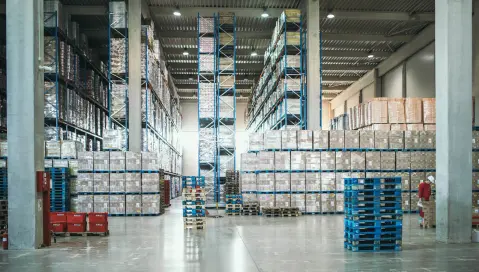2021 Distribution Recap: What We Learned and Where We’re Going
2021 Distribution Recap: What We Learned and Where We’re Going
2021 Distribution Recap: What We Learned and Where We’re Going
23 Dec 2021
Aptean Staff Writer
As the year winds to a close, we pause for thoughts and reflections. For almost two years now, the COVID-19 pandemic has been at the forefront, affecting every aspect of how we live and how we work. That’s not new; but what is new is how the distribution industry will respond to it.
What We Learned
Due to the pandemic, fundamental changes to consumer behaviors that were already occurring were quickly accelerated. Online shopping exploded. Consumers were buying everything online, from groceries to pharmacy items. Contact-free practices became the norm, particularly in the retail sector. Health and safety concerns were paramount. Many companies shifted to remote or hybrid work.
The service and hospitality industry took a huge hit and is still struggling to recover. The change occurred as consumers shifted their spending more toward consumption of goods rather than services. The supply chain, already overtaxed due to the massive surge in home delivery, may not improve until 2023, according to several industry analysts.
As the pandemic slowly winds down, we can spot patterns that were fueled by the pandemic and those that will remain once we emerge from its dark shadow.
In the below article, we’re going to examine the trends that will last, and how consumer goods distributors can rise to meet them.
Where We’re Going
1. Direct-to-Consumer (D2C) Channel Shifts
Consumers have changed their shopping preferences due to the pandemic, but that trend was on the rise before the pandemic forced its acceleration. Many consumers, even older generations, are shopping online rather than in retail establishments. 95% of analysts believe that the remote work trend will continue, which means that the predominant home consumption trend will continue as well. Wily consumer goods distributors should, if they haven’t already, capitalize on this channel shift.
D2C isn’t a new concept—it was the norm for decades as merchants in cities and villages throughout the world sold their goods directly to the people that entered their establishments. Modern technology and transportation changed the way people shopped, as wholesalers and distributors offered goods from everywhere at lower prices.
It’s all about rethinking your market strategy. If you aren’t ready to make the shift into direct-to-consumer yet, consider trying a hybrid model, where you keep your profitable retail partnerships and choose a product to sell directly to consumers. If you choose to change your strategy to full D2C, be aware that your company must take on all the roles and responsibilities for getting your products to the consumers.
Technology is the key to achieving any kind of D2C strategy. Aptean’s Distribution ERP with built-in EDI and our eCommerce platform can get you there.
2. Digitalization and the Cloud
The terms “digitalization” and “digital acceleration” have become buzzwords of late, but that does not make them less valid. According to Technopedia, digital transformation is using digital technology to transform core business processes to make data-driven decisions, improve core efficiencies, and gain competitive advantage.
The consumer shift to online shopping means that distributors must make that shift, also. Even if your company stays in the B2B sector, having an ecommerce platform will help you increase sales and improve brand recognition. Your aim is for operational improvement.
Consumer goods distributors must improve productivity across the board. Think about bolstering internal processes and efficiencies with technology. If you have not thought about automating your processes before, now is the time. And with the uptick of network attacks, protecting your data is essential. The FBI stated that the pandemic ushered in a wave of cybercrime, and reported a 400% increase. Moving your systems into the cloud can protect you from risk while optimizing your processes for maximum efficiency.
Your distribution business must be agile to survive in a post-pandemic era. Supply chain disruption will remain through the next year, so you must ensure that there are no errors or inconsistencies in your supply chain processes. For your business, digital transformation will help you stay ahead of the industry changes and challenges.
Aptean’s Distribution ERP software helps distribution companies like yours direct their supply chain and logistics activities. The software comes with built-in warehouse management, inventory management and order management, and integrates these activities with the company’s financials and sales. It’s also backed by the power of Microsoft Azure so you can be sure your data is secure.
3. Sustainability
Today’s consumers, particularly younger consumers, have stated that they would only buy goods from brands that have values like theirs. In addition, countries across the globe are increasing international restrictions on carbon emissions. According to McKinsey, 65% of nations have committed to a zero-net emissions policy by 2050, with many countries focused on an even faster timeline. For distribution companies, this means that they must accommodate this shift and transform their operations to concentrate on sustainability.
This trend isn’t new—the push toward corporate responsibility and environmental stewardship has been gaining momentum for several years now. Today’s consumer wants to know where their goods have been sourced and whether the company that provided them has used all possible safety precautions. That means that our reliance on goods from overseas has waned. In fact, over 70% of consumers surveyed said that they would be willing to pay more for sustainable goods.
For distributors, this means that your focus needs to be on complete visibility in the supply chain and streamlined, efficient operations. If you’re still using manual processes or a legacy ERP, you’ll never get there.
Your consumer goods business must capitalize on the right technology to drive efficiency, streamline operations and improve sustainability efforts. Aptean’s Distribution ERP can help you do that.
4. Strengthening the Supply Chain
We’ve been hearing about global supply chain woes for months now. Between the public health crisis and geopolitical issues like Brexit and the U.S./China trade war, supply chain disruptions have become more frequent and more urgent. Many people try to blame the pandemic, but the pandemic only highlighted the issues that were already present.
Before, managing the supply chain simply meant keeping minimal inventory and bringing in low-cost supplies. While that is still important, the main emphasis in years to come must be on resilience. Companies must invest in digital tools to gain full visibility throughout the supply chain. With costs of freight rising, material shortages and logistics challenges, distribution companies need the right technology to enable product tracing and allow for greater supplier diversity. A strong digital platform will also allow distributors to make the switch to D2C should they choose to do so.
Resiliency in the supply chain comes down to being agile. If the supply chain breaks again—and it will—how can you recover? If you have the right technology in place, you’ll be armed with the right data and you’ll be nimble enough to experiment with different go-to market strategies and new business models.
Distribution companies can employ different strategies to ensure that they always have inventory on hand. Some are diversifying suppliers, while others are avoiding globalization altogether. Whatever strategy you choose, you’ll need the data and analytics to help you plan and predict demand and future-proof your business.
Aptean’s Distribution ERP has integrated EDI, warehouse management and supply chain management tools. You can improve processes, visibility and control across your supply chain, which results in lower costs, enhances sustainable business practices, and leads to higher profits. Find out how, now.
Begin vandaag nog met het transformeren van uw final mile
Bent u klaar om uw distributieactiviteiten naar een hoger niveau te tillen? Dan helpen we u graag.



